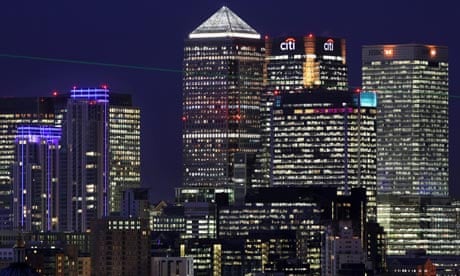Canary Wharf, the "second City", an "evil twin" to London's financial district, has overtaken its ancient rival, according to the Financial Times. It wouldn't be altogether surprising if some saw this as a cause for celebration. Canary Wharf, and the 1980s Docklands development of which it was the most successful part, was an enterprise zone, an idea that the current government is trying to revive. As an enterprise zone it was deliberately unplanned, low-tax, and in theory low on "big government", except for the not-so-small matter of massive public investment projects such as the Docklands Light Railway or the cleaning, dredging and decontaminating of the old industrial sites. Regardless, if it has "worked", then surely the coalition's new zones can point to it as some kind of model. One form of industry, the dock labour of the Port of London, was replaced with another, financial services. Around 80,000 jobs in the former, 150,000 in the latter. What could possibly be wrong with this?
Everything. Canary Wharf has been for the last 20 years the most spectacular expression of London's transformation into a city with levels of inequality that previous generations liked to think they'd fought a war to eliminate. Very, very few of the new jobs went to those who had lost their jobs when the Port of London followed the containers to Tilbury; those that did were the most menial – cleaners, baristas, prostitutes. The new housing that emerged, first as a low-rise trickle in the 80s and 90s followed by a high-rise flood in the 00s, was without exception speculatively built. Inflated prices, dictated by the means of a captive market of bankers, soon forced up rents and mortgages in the surrounding areas, a major cause of London's current acute housing crisis.
Looked at in the long term, Canary Wharf is the final victory of "old corruption", the financier-rentier capitalism centred on the City and landowners over industry, literally building its new edifices on top of spaces formerly devoted to manual labour and working class organisation. Thatcherites, early on, liked to think their race-to-the-bottom policies on wages and unions might rejuvenate British industry, but Canary Wharf is the place where that was shown up for the myth it always was. Instead, old money got computers, built itself glass skyscrapers, hid its old-school ties and transformed itself into a gigantic offshore money-making mechanism.
The ludicrous nonsense of "trickle-down economics" is exposed in Canary Wharf more than anywhere else in Europe. A 10-minute walk away is Balfron Tower, a listed, proud but under-maintained tower of council housing, designed by the architect Erno Goldfinger, currently owned by a housing association. Recently it emerged that renovations there would have to be paid for by selling the flats on the open market. There was no other way of raising money, apparently. And just opposite is some of the most apparently overflowing wealth in world history. Around Balfron Tower you can find the largely low-rise Lansbury estate, built as part of the Festival of Britain, similarly covered in grime and pigeon shit and beset by rampant unemployment; or Robin Hood Gardens, where an architectural hoo-ha over impending demolition has masked another incursion of Canary Wharf's bankers and its values into the area. If anyone in any of these estates has seen anything trickle down it would be an unpleasant-smelling liquid running from a great height.
So how has the myth that this place has done anything for east London other than compounding its misery managed to endure? How, with this massive counter-argument against trickle-down, have similar projects from Manchester to Portsmouth managed to hold it up as a model? Perhaps it's just the sheer visibility of Canary Wharf, its seductive size and shininess, its malignant growth. It had a false start, and for years, "Thatcher's cock" stood tumescent but alone.
It was really New Labour that was intensely relaxed about the place, with most of the skyscrapers dating from the 2000s, the years in which it became something yet more malevolent. In a piece published at the start of the financial crisis, the late political essayist Peter Gowan called it "Wall Street's Guantánamo", the place where the likes of Lehman Brothers could escape the relative rigours of US law and fully indulge in the fictitious capital of credit default swaps and collateralised debt obligations. There are few places on earth so completely and utterly implicated in our current discontents, or anywhere so due a serious reckoning. Somehow, rioters missed it last August, the barrier of the arterial road that severs it from Poplar perhaps seeming impassable. Maybe they'll reach it next time.
